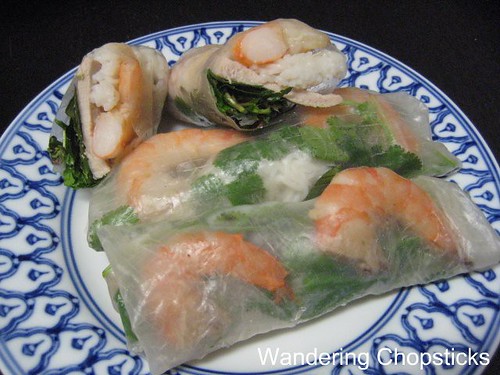
I've always thought of goi cuon as fairly mainstream. I mean, it's like pho - ubiquitous. Mention Vietnamese food and most people automatically think of pho and goi cuon. Or even if they've never seen rice paper before, the concept of wrapping something shouldn't be all that unusual. Especially if you're Asian, doesn't everyone have their own variation of eggrolls? So while the filling may be different, the wrapping or rolling of it is more or less the same. Or even if you're not Asian, I think burritos and fajitas are common enough to make the concept of wrapping food, well, rather common.
But I guess for someone who might have never actually encountered banh trang (rice paper) before, it would be a complete mystery. So back to my story about Golden Deli.
While waiting for a spot, I was standing beside a table of three Asian women. One of them asked the waiter how they were supposed to eat the rice paper. He said they were supposed to put a little bit of the meat and salad onto the rice paper and roll. I could tell they still didn't understand the concept because well, because I actually looked over to see what they had on their table.
So picture this: a plate with a six-inch triangle of rice paper on it, with an entire large green lettuce leaf on top of that, one 1-inch piece of nem nuong (Vietnamese grilled pork patty) in the center, and dipping sauce drizzled on top. And because the waiter had left with his not-so-precise-instructions, I decided to be helpful. I said to only take a small piece of lettuce so it would fit inside the rice paper. She tore off a few inches of the lettuce to put back on the plate of herbs, but still left the entire rest of the lettuce leaf on the rice paper. She also gave me a dirty look and said she could figure it out on her own. Oookay. Well, at least the rice paper was already soaked or else she would have been truly lost. As it was, they never did figure it out.
Which made me remember when a Chinese-American friend had tried to make salad rolls from a Cooking Light recipe. She followed the directions exactly and couldn't figure out why she always ended up with mush instead of pliable rice papers. The exact directions? Soak rice paper in cold water for two minutes.
And that memory triggered a long buried one from a decade ago when my American Intervention in Vietnam college class dined out on Argyle, the main street in Chicago's Vietnamese area. (I refuse to call the area "New Chinatown" but that's another rant.) Classmates thought the rice paper was plate lining. I couldn't figure out whether they thought it was merely decorative or if the plates were dirty or what. But I do know they were really surprised when our prof said the rice paper was meant for eating. At least the confusion my classmates had was somewhat understandable. They were all white. I guess I just expected Asians to be a little familiar with other Asian cuisines.
If it seems like I'm emphasizing too many words, well, it's probably because I'm always surprised when people aren't familiar with rice paper. Oh dear, this probably makes me sound snotty but really, where have these people been? It's been more than three decades since the Vietnamese have been in America and contributed to the transformation of the American culinary scene.
Goi cuon literally translated is salad rolls - goi (salad) cuon (roll). I have no idea where summer rolls originated from but it's most likely because the herbs or salad that we use to wrap them up with are usually in season during the warmer months. Or perhaps it was to distinguish from fried egg rolls, which are sometimes called spring rolls.
When you buy goi cuon in stores or restaurants, they usually come already rolled for you. But when eating at home with the family, everyone rolls their own. Perfect for the lazy cook.
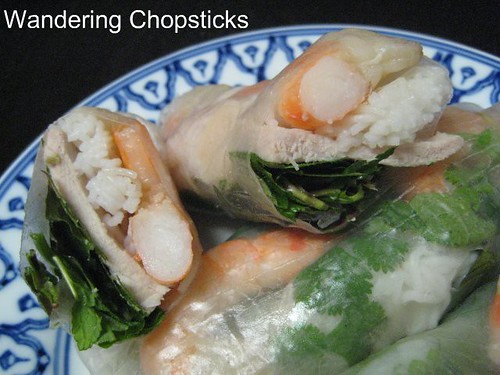
Goi Cuon (Vietnamese Salad/Summer Rolls)
You'll need:
1/2 to 1 lb pork, preferably with skin attached, or without, for those concerned about fat content
1/2 to 1 lb jumbo shrimp, plan on two shrimp per roll, or one shrimp per roll if you plan to slice shrimp in half
"salad" can be any kind of lettuce and herbs, preferably mint, rau ram (Vietnamese coriander), cilantro, perilla, etc.
package of rice paper
package of rice vermicelli noodles, not to be confused with bean thread vermicelli noodles
Boil pork and shrimp. Boil noodles and allow to drain in colander.
More precise instructions you say? Fill 5-quart stock pot halfway with water and a dash of salt. When water boils, add pork and turn heat down to medium. Allow to simmer until meat is fully cooked, when a knife or fork jabbed into the meat runs clear and not bloody. Take meat out and allow to rest for about 15 minutes, or until pork is cool enough to touch. Slice thinly.
While pork is resting, toss shrimp into pot. It should take only a few minutes for the shrimp to turn pink and be fully cooked. Scoop shrimp out and onto a plate. For optimum juiciness, keep shells on, and allow guests to peel the shells at the table. But shelled shrimp is perfectly acceptable. You can also halve shrimp if they're very large, or you're frugal.
Save the broth, I've got another recipe below.
At the table, you would see a plate of the sliced pork, shrimp, noodles, herbs, and rice paper, along with a bowl of warm water for soaking the rice paper.
Gently slide the rice paper into the water until it is all covered. You want the rice paper to be just wet enough that it will turn pliable in a few minutes, but it should still be stiff when you take it out. When you're assembling your goi cuon, the stiffness will turn pliable. If you literally soak your rice paper, in a few minutes it'll turn to mush and fall apart.
Now here comes the assembly part. I also have video instructions on how to roll rice paper.
Place two shrimp on upper portion of rice paper. As you can tell, the step-by-step photos were from an earlier batch when I only had iceberg lettuce on hand. Notice how the rice paper is wet but still stiff. It'll become pliable in seconds.

Then add noodles, lettuce and herbs, and a slice or two of pork.
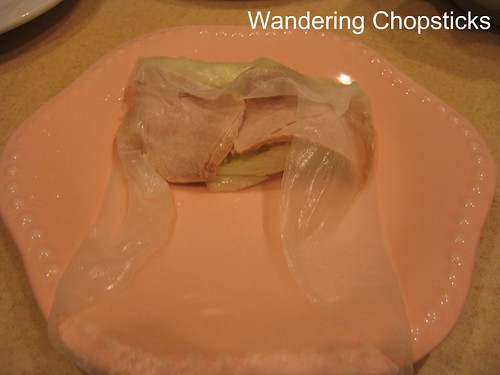
Fold in the two sides. You want it to just touch the edges of your filling so that it will be tight enough to hold everything in.
Then fold top edge down, gently pushing in filling as you go along.
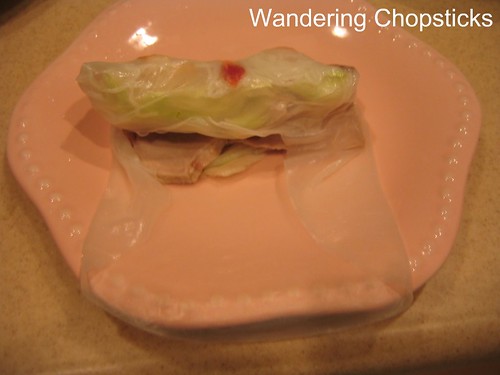
It's basically how you would roll an eggroll, but because the rice paper is so thin, more gentleness is needed so the fillings don't push through the wrapper.
Also, don't be too greedy and try to wrap everything in your roll at once because it will become a mess.
Rolling.
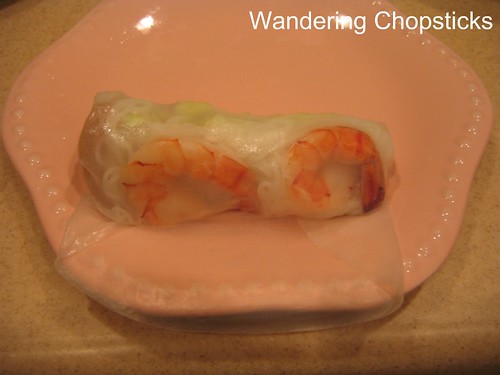
And rolling.
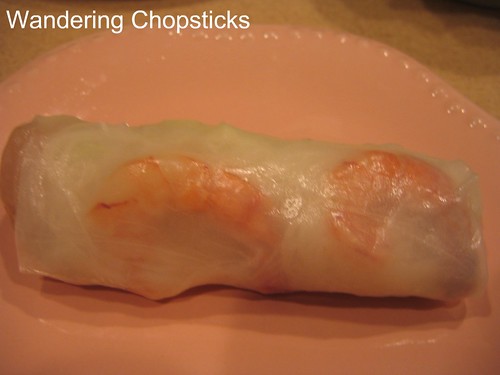
And voila!
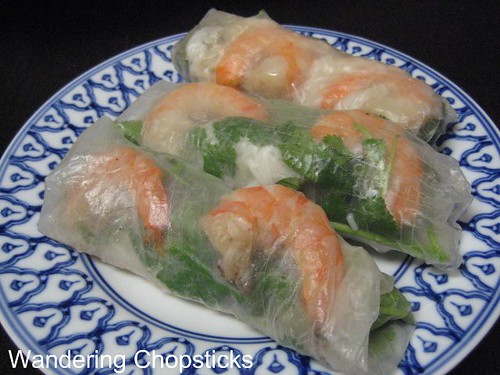
A perfectly wrapped spring roll. Placing the shrimp first when you're rolling means the pretty color shows through on the outside of the rice paper. Adding the noodles second helps emphasize the pinkness.
If you want to serve a bunch of these as appetizers, you shouldn't make them more than a few hours before you plan to eat them because the rice paper will turn hard again. Cover with wet paper towels to keep rice paper soft and pliable if you do so. Or wrap them individually in plastic.
Assembling at the table is much more sociable though. And since the preparation is so quick, they're great for lunch or dinner parties.
You can serve these with Nuoc Mam Cham (Vietnamese Fish Dipping Sauce), hoisin dipping sauce, plum sauce, sweet chili sauce, or as I prefer it, fermented shrimp sauce.
Now, about that broth. You can use it to make Canh Cu Sen (Vietnamese Lotus Root Soup).
Enjoy!

Hi, I hopped over from Budding Cook's blog. I like to drink soup and also use pork and dried shrimp as my soup base. For this lotus root soup, I was wondering for how long did you simmer the lotus roots?
ReplyDeleteHi SimCooks,
ReplyDeleteThanks for pointing this out. I think I did 15 minutes? I like mine crunchy and closer to raw. Let me make edits to the recipe.
WC,
ReplyDeleteWhat silly women.
- Chubbypanda
nummy!
ReplyDeleteoh btw, i added you to my blogroll for quick clicking. goi cuon is one of my favorite dishes to pick up from the fast food stores etc. i love peanut sauce. ;) i lick it up.
ReplyDeleteHi Bill,
ReplyDeleteEgg whites huh? I like omelets rolled up in rice paper. Add a dash of fish sauce into the eggs as you're scrambling them and there's no need for dipping sauce.
CP,
I know! They were mean. I was only trying to be helpful. Ah well, if they want to remain clueless...
Budding Cook,
You know, I hardly ever buy goi cuon to-go because it's always full of noodles and I like the meat! :)
Oh, now I know the name - goi cuon. I would always call it sping roll, even if not fried. And thanks to you, the next time I dine out, order goi cuon and see water in front of me, I know it's for me to wet the rice paper. Then I would not look like a fumbling idiot :0
ReplyDeleteHi Tigerfish,
ReplyDeleteDon't dip the goi cuon in water, it's already been wet and rolled. :)
Awww... my stomach is growling....
ReplyDeleteAnonymous,
ReplyDeleteThanks. Heh, I was thinking these look kinda bland when I took the photos. Glad someone liked them. :)
Those look delicious. I can see that I'd have the same problem as I have with tacos - I put too much in and then can't roll them properly. As you say, too greedy. :-) I've never heard of eating rice paper before, so I learned something today. Thanks!
ReplyDeleteHi Cookie Baker Lynn,
ReplyDeleteRice paper is a lot lighter eating then tacos. :)
Yeah!
ReplyDeleteI FINALLY got the whole rolling technique down! It took a while to master, but I'm a rolling master now.
Jaden,
ReplyDeleteYay! :)
yeah i'm never taking multiple foreign friends again to bo bay mon. i couldn't eat b/c everyone needed instructions. jeez! :P
ReplyDeleteVan,
ReplyDeleteI remember you telling me about that. Sometimes I don't mind giving instructions but sometimes, I just want to eat!
I was thinking of making a few of these this weekend but my head started spinning when I got to the rice paper rolls in the store, is there a brand you recommend? I'd hate to go through the effort and have sub par wrappers.
ReplyDeleteLilly,
ReplyDeleteThree Ladies brand has always worked for me. Choose the clear kind with tapioca flour if you want a chewier rice paper, and opaque rice flour only for normal rice paper. Just remember not to soak them. Just wet each side and the rice papers will become pliable as you fill and roll them. Good luck!
At last! An easy (and clear) recipe for Vietnamese spring rolls. :)
ReplyDeleteThank you. Can't wait to make these.
Brenda,
ReplyDeleteGlad to be of help. I always think it's pretty easy, but then I've grown up eating and making them all the time. :)
Hi WC,
ReplyDeleteJust wanted to let you know that I made these yesterday and they turned out wonderful, i.e. looks and tastes just like the restaurants, now I don't have to spend a forture ordering these summer rolls anymore! Thank you so much for the recipe and for demystifying Viet cuisine in general, I have plans to tackle your spring rolls recipe next, having been emboldened by my small success yesterday. By the way, I have a recipe request, although I'm not sure where to post for that, it's Bun Rieu, I've checked the entire site but there isn't a recipe for that. I'd be eternally grateful if you could enlighten us on how to go about preparing this at home since it doesn't seem to be a widely available/ too popular choice at restaurants. I recall that there were tomatoes, tofu triangles and this salty small pork meatball/mixture thingy, and would love to be able to make it at home. Many thanks in advance, and please keep those recipes coming!
Roberta,
ReplyDeleteGlad the recipe turned out well for you. I do try to make VNese food as accessible as possible.
I don't really do recipe requests. I just cook what I feel like when I feel like it. That said, I do keep in mind some of the more popular requests in case I feel like making it.
Oh, I love these! My family and I make this all the time. Our aunt is actually the one who introduced us. Apparently she learned from a Vietnamese friend (we're Korean). I guess, we've probably made them very "our own," though (and not very authentic), by the sheer quantity of things we include in it. We include: lettuce, onions, julienned carrots, julienned cucumbers, rice noodles, peanuts, pineapple chunks, bean sprouts, cilantro, mint, and our protein of choice is thin-sliced beef. We do use shrimp sometimes, but we seem to prefer the beef... As for the sauce, what we make is a combination of Thai chilis (those tiny, lethal ones), soy sauce, fish sauce, garlic, lemon (sometimes lime) juice...and I'm sure something else... But we like ours spicy :)
ReplyDeleteThanks for this recipe, I blogged about my Vermont version of these (using local ingredients), and cited this post heavily! Overall I'm just shocked at how easy these are to make once you try. Cheers & best, Prof. K
ReplyDeleteI wanted to look up Canh Cu Sen (Vietnamese lotus root soup) but the link keeps taking me here. Do you have the recipe for that? Thanks.
ReplyDeleteGeorge,
ReplyDeleteI've wrapped bulgogi in rice paper so it's all good. :P
Prof Kitty,
Anything wrapped in rice paper is good in my book!
U_Huynh,
Ah, I've been meaning to make a separate entry for the canh cu sen, but haven't gotten around to it. The directions for the lotus root soup are right there at the end of this post though.